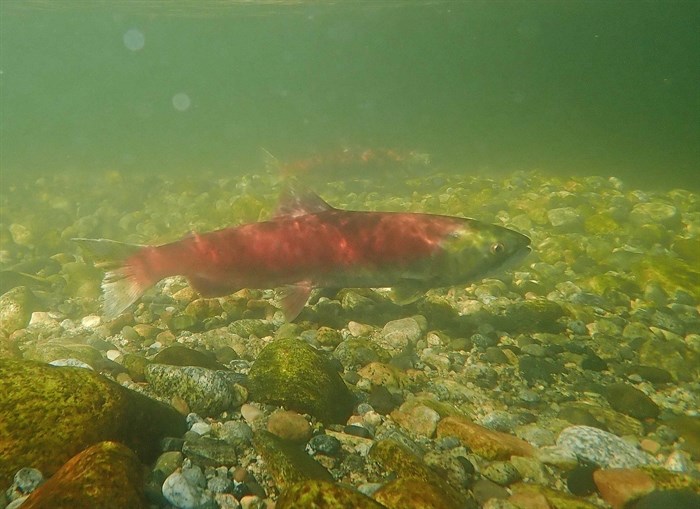
An Okanagan sockeye salmon in the Okanagan River.
Image Credit: SUBMITTED/Okanagan Nation Alliance
May 02, 2020 - 8:30 AM
It's roughly a 1,000-kilometre journey that's all upstream and it's estimated 150,000 Okanagan sockeye salmon are soon to start the treacherous trip back to the southern Okanagan.
Roughly 120,000 are expected to make it back to the Okanagan and will start to appear in Osoyoos and Skaha Lakes mid-June.
It's a far cry from salmon numbers in the 1990s when as few as 2,500 Okanagan sockeye salmon would make it back to the southern Interior. The success of bringing the salmon back from the brink of extinction has been due to a collaborative effort spearheaded in B.C. by the Okanagan Nation Alliance.
"A lot of people that we talk to don't even know that there's salmon in the Okanagan," Okanagan Nation Alliance fisheries program manager Howie Wright told iNFOnews.ca. "We forecast right now about 150,000 Okanagan original sockeye coming back to the Columbia (river)."
The Okanagan sockeye getting ready to start their journey back to Canada are currently in the Pacific Ocean heading towards the mouth of the Columbia River, 150 kilometres north-west of Portland, Oregon. From there, the sockeye will head east upstream in the Columbia River which acts as a border between Oregon and Washington states. The river then turns north and leads to the Okanagan River around 100 kilometres south of the Canadian border. From there the sockeye swim north in the Okanagan River, cross the border and ultimately end up in Osoyoos and Skaha Lakes.
It's a mammoth journey in which the sockeye will have to navigate nine hydroelectric dams and a multitude of other threats.
"Columbia Okanagan sockeye have a four-year cycle," Wright said. "These fish coming back now in 2020 were the ones that were spawning in October of 2016 (in the Okanagan)."
Wright said he expects the sockeye to arrive mid-June to early July and they will spend the rest of the summer in the lakes, before heading to the Okanagan River and the Penticton channel to spawn in early fall. The adults then die and the fertilized eggs spend the winter under gravel before emerging and swimming back to either lake for a year.
"After that year... (they'll) leave the lake and head downstream, down the Okanagan River into the U.S. and down to the Columbia River and ... head out to the ocean for one to two years, before they complete the cycle again and come back up," Howie said.
The success of the programs and work done on habitat restoration, improving water management, habitat access, and reintroducing stock enhancement over the last two decades has had a dramatic effect on the salmon.
"In 2003 and 2004 (we) started doing a release (of sockeye) in the Penticton channel and since we've been doing that we've been getting returns of sockeye," he said.
Wright said they've seen as many as 220,000 Okanagan sockeye in one year, and this year's estimate of 150,000 is a good return number.
So what happens to all the fish?
"The first priority is FSC," said Wright. "Food, social, ceremonial."
Wright said once local first nations and conservation are addressed, the Department of Fisheries may open up recreational fishing. Those with a licence will be able to catch two sockeye per day, with the fish weighing on average between two and four pounds.
"They're a bit milder tasting (than other sockeye)," Wright said. "They are very good tasting fish."
To contact a reporter for this story, email Ben Bulmer or call (250) 309-5230 or email the editor. You can also submit photos, videos or news tips to the newsroom and be entered to win a monthly prize draw.
We welcome your comments and opinions on our stories but play nice. We won't censor or delete comments unless they contain off-topic statements or links, unnecessary vulgarity, false facts, spam or obviously fake profiles. If you have any concerns about what you see in comments, email the editor in the link above.
News from © iNFOnews, 2020